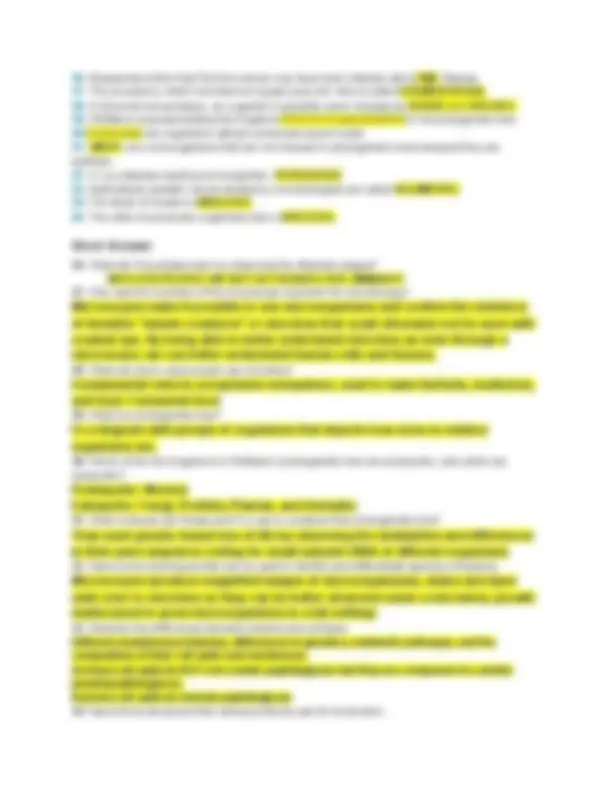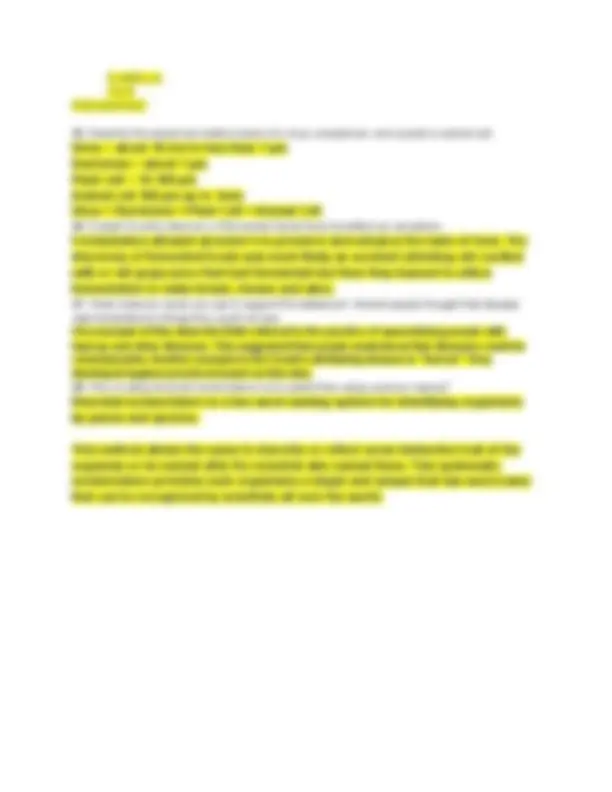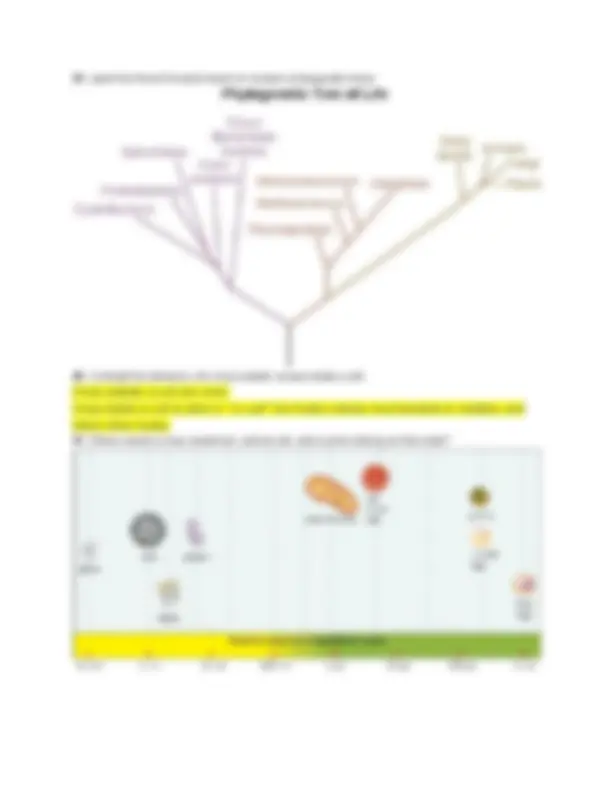Download Microbiology Week 1 review and more Lecture notes Microbiology in PDF only on Docsity!
MICRO WEEK ONE
Multiple Choice
1. Which of the following foods is NOT made by fermentation?
- beer
- bread
- cheese
- orange juice 2. Who is considered the “father of Western medicine”?
- Marcus Terentius Varro
- Thucydides
- Antonie van Leeuwenhoek
- Hippocrates 3. Who was the first to observe “animalcules” under the microscope?
- Antonie van Leeuwenhoek
- Ötzi the Iceman
- Marcus Terentius Varro
- Robert Koch 4. Who proposed that swamps might harbor tiny, disease-causing animals too small to see?
- Thucydides
- Marcus Terentius Varro
- Hippocrates
- Louis Pasteur 5. Which of the following was NOT a kingdom in Linnaeus’s taxonomy?
- animal
- mineral
- protist
- plant 6. Which of the following is a correct usage of binomial nomenclature?
- Homo Sapiens
- homo sapiens
- Homo sapiens
- Homo Sapiens 7. Which scientist proposed adding a kingdom for protists?
- Carolus Linnaeus
- Carl Woese
- Robert Whittaker
- Ernst Haeckel
8. Which of the following is NOT a domain in Woese and Fox’s phylogenetic tree?
- Plantae
- Bacteria
- Archaea
- Eukarya 9. Which of the following is the standard resource for identifying bacteria?
- Systema Naturae
- Bergey’s Manual of Determinative Bacteriology
- Woese and Fox’s phylogenetic tree
- Haeckel’s General Morphology of Organisms 10. Which of the following types of microorganisms is photosynthetic?
- yeast
- virus
- helminth
- alga 11. Which of the following is a prokaryotic microorganism?
- helminth
- protozoan
- cyanobacterium
- mold 12. Which of the following is acellular?
- virus
- bacterium
- fungus
- protozoan 13. Which of the following is a type of fungal microorganism?
- bacterium
- protozoan
- alga
- yeast 14. Which of the following is not a subfield of microbiology?
- bacteriology
- botany
- clinical microbiology
- virology
Fill in the Blank
15. Thucydides is known as the father of SCIENTIFIC HISTORY
FLAGELLA
CILIA
PSEUDOPODS
35. Describe the actual and relative sizes of a virus, a bacterium, and a plant or animal cell.
Virus = about 10 nm to less than 1 μm
Bacterium = about 1 μm
Plant cell = 10-100 μm
Animal cell 100 μm up to 1mm
Virus < Bacterium < Plant Cell < Animal Cell
36. Explain how the discovery of fermented foods likely benefited our ancestors.
Fermentation allowed ancestor's to preserve and enhance the taste of food. The
discovery of fermented foods was most likely an accident (drinking old curdled
milk or old grape juice that had fermented) but then they learned to utilize
fermentation to make bread, cheese and wine.
37. What evidence would you use to support this statement: Ancient people thought that disease was transmitted by things they could not see. One example of this when the Bible referred to the practice of quarantining people with leprosy and other diseases. This suggested that people understood that diseases could be communicable. Another example is the Greek's attributing disease to "bad air" They developed hygiene practices based on this idea. 38. Why is using binomial nomenclature more useful than using common names?
Binomial nomenclature is a two-word naming system for identifying organisms
by genus and species.
This method allows the name to describe or reflect some distinctive trait of the
organism or be named after the scientist who named them. This systematic
nomenclature provides each organisms a single and unique that two-word name
that can be recognized by scientists all over the world.
39. Label the three Domains found on modern phylogenetic trees. 40. Contrast the behavior of a virus outside versus inside a cell.
Virus outside a cell are inert.
Virus inside a cell is able to "co-opt" the hosts cellular mechanisms to multiply and
infect other hosts.
41. Where would a virus, bacterium, animal cell, and a prion belong on this chart?
Molds are also found in soils, rotting foods, and dank corners. Molds play a critical role in the decomposition of dead plants and animals into rich
Explain how a prism separates white light into different colors.
White light can be separated into its component colors using refraction. When white
light passes through a prism different colors will be refracted in different directions,
creating a rainbow-like spectrum on a screen behind the prism. The separation of colors
is called dispersion and its occurs when, for a given material, the refractive index is
different for different frequencies of light.
.Why is Antonie van Leeuwenhoek's work much better known than that of Zaccharias
Janssen?
"father of microbiology"HE IS CREDITED FOR THE DISCOVERY OF
MICROORGANISMS, OTHERS BEFORE HIM HAD CONTRIBUTED TO THE
DEVELOPMENT OF THE MICROSCOPE. HE SUBMITTED HIS WORK IN DETAIL TO
THE ROYAL SOCIETY SO IT WAS BETTER KNOWN.
Zaccharias Janssen is credited with developing the telescope, the simple microscope,
and the compound microscope (although it is possible it was their neighbor Hans
Lippershey). JANSEEN WAS VERY SECRETIVE WITH HIS WORK AND NEVER
PUBLISHED.
Why did the cork cells observed by Robert Hooke appear to be empty, as opposed
to being full of other structures?
They appeared to be filled with air because the cork cells were dead. The only structure
provided were rigid cell walls.
What is the function of the condenser in a brightfield microscope?
Focuses all light rays on specimen to maximize illumination.
How could you identify whether a particular bacterial sample contained specimens
with mycolic acid-rich cell walls?
You can identify if a specimen has mycolic acid-rich cells walls by performing an acid-fast stain. An acid-fast stain is able to differentiate two types of gram-positive cells (those with mycolic acid-rich cell walls and those that do not).














